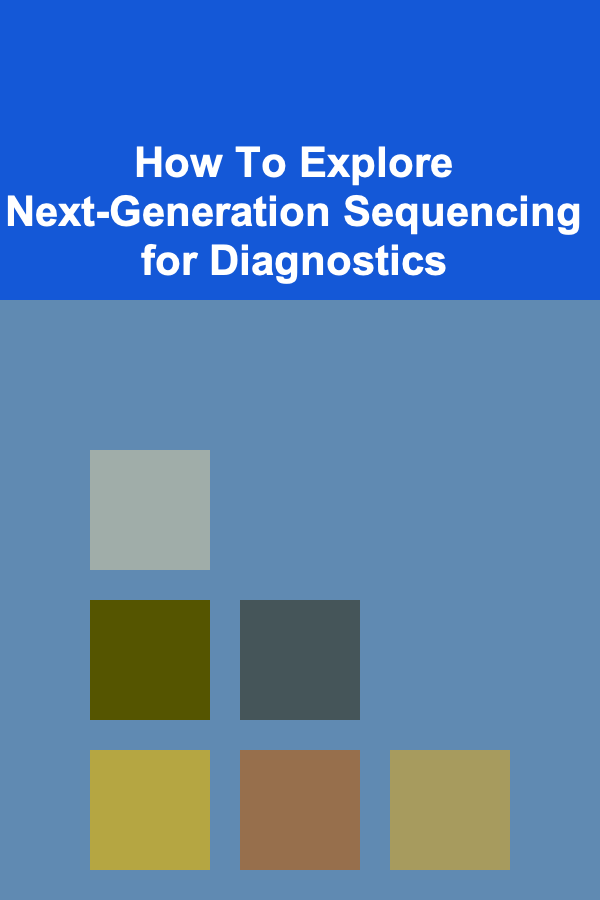
How To Explore Next-Generation Sequencing for Diagnostics
ebook include PDF & Audio bundle (Micro Guide)
$12.99$11.99
Limited Time Offer! Order within the next:

Next-Generation Sequencing (NGS) has revolutionized the landscape of genomics, enabling a deeper and more detailed understanding of genetic information than ever before. NGS technology has gone from being a specialized research tool to becoming a cornerstone in clinical diagnostics. In this article, we will explore how to effectively utilize NGS for diagnostics, discussing its principles, applications, challenges, and future directions. We will also consider how NGS can address the current limitations in diagnostics and improve healthcare outcomes.
Introduction to Next-Generation Sequencing (NGS)
NGS refers to a collection of modern sequencing technologies that allow for the simultaneous sequencing of millions of DNA fragments, drastically increasing the speed, accuracy, and scalability compared to traditional methods like Sanger sequencing. NGS works by breaking down DNA into smaller segments, reading them in parallel, and then reconstructing the full sequence using sophisticated computational algorithms.
The power of NGS lies in its ability to generate massive amounts of data, enabling the sequencing of entire genomes, exomes, or targeted regions. This capability has led to the development of a variety of diagnostic applications, from identifying genetic disorders to detecting pathogens and cancer mutations.
Key Principles of NGS Technology
- Parallel Sequencing: Unlike Sanger sequencing, which reads one DNA fragment at a time, NGS technology sequences millions of fragments simultaneously. This increases throughput and reduces the time and cost involved in sequencing.
- High-Throughput and Accuracy: NGS platforms provide a high level of accuracy, with error rates significantly lower than previous sequencing technologies. This makes it suitable for applications where precision is critical, such as diagnostics.
- Bioinformatics Analysis: The raw data produced by NGS requires significant computational analysis to assemble the sequence, align it to a reference genome, and identify variants. Specialized bioinformatics tools are used to filter out noise, interpret genetic variants, and generate clinically relevant information.
- Massive Data Generation: NGS generates vast amounts of data that need to be stored, analyzed, and interpreted. Cloud-based platforms and specialized software tools have become essential in managing the data produced by NGS.
Applications of NGS in Diagnostics
NGS has opened up a wide array of diagnostic applications, revolutionizing how we approach diseases, genetic conditions, and infections. Some of the most significant diagnostic applications of NGS include:
1. Genetic Disorders and Rare Diseases
One of the most transformative uses of NGS in diagnostics is the identification of genetic disorders, especially rare diseases. NGS enables the sequencing of entire genomes or exomes (the protein-coding regions of the genome), allowing clinicians to pinpoint mutations responsible for genetic diseases.
- Whole-Genome Sequencing (WGS): WGS allows for a comprehensive analysis of all 3 billion base pairs in the human genome. This can uncover previously unknown genetic mutations and help with the diagnosis of complex conditions like mitochondrial disorders or intellectual disabilities.
- Whole-Exome Sequencing (WES): WES focuses on the exons of the genome, where most known disease-causing mutations are located. It is particularly useful for diagnosing rare and undiagnosed genetic disorders.
- Targeted Gene Panels: For conditions with known genetic causes, targeted panels are used to sequence specific genes associated with the disease. This is more cost-effective than WGS or WES and can be used to quickly diagnose conditions like cystic fibrosis, Duchenne muscular dystrophy, or Huntington's disease.
2. Cancer Diagnostics
NGS has become a critical tool in oncology, where its applications range from early detection to identifying treatment options based on genetic mutations. Tumor sequencing, also known as liquid biopsy, involves sequencing the DNA of cancer cells found in blood, saliva, or urine.
- Somatic Mutations: NGS can identify somatic mutations in tumors that drive cancer development. This can be used to determine the most effective treatment options, as certain mutations make tumors responsive to specific targeted therapies.
- Minimal Residual Disease (MRD): NGS is also used to detect minimal residual disease, which refers to small numbers of cancer cells that remain after treatment. This allows for more accurate monitoring of patients in remission and can help identify relapses early.
- Tumor Profiling: Comprehensive tumor profiling using NGS can identify genetic mutations, fusions, and copy number variations, providing insights into the molecular drivers of cancer and enabling personalized treatment strategies.
3. Infectious Disease Diagnostics
NGS has revolutionized the way we approach infectious diseases. It enables the detection and characterization of pathogens, including viruses, bacteria, and fungi, in a way that traditional culture-based methods cannot.
- Pathogen Identification: NGS can rapidly sequence the genomes of pathogens from clinical samples, providing detailed information about the causative organisms of infections, including rare or previously uncharacterized pathogens.
- Antimicrobial Resistance (AMR): NGS can identify genetic markers associated with antimicrobial resistance, helping clinicians choose the most effective antibiotic treatments.
- Outbreak Tracking: NGS can also be used for epidemiological surveillance, helping track the spread of infectious diseases by comparing pathogen genomes from different locations or time periods. This was particularly evident during the COVID-19 pandemic, where NGS was used to track virus mutations.
4. Pharmacogenomics and Precision Medicine
NGS allows for a better understanding of how individuals respond to drugs based on their genetic makeup, a field known as pharmacogenomics. By sequencing the genomes of patients, clinicians can predict which drugs are most likely to be effective, as well as avoid harmful side effects.
- Drug Metabolism: Variants in genes related to drug metabolism, such as those in the cytochrome P450 family, can affect how well a patient responds to certain medications. NGS can identify these variants, enabling clinicians to tailor drug prescriptions accordingly.
- Cancer Treatment: In oncology, pharmacogenomics can help determine which chemotherapies will be most effective based on a patient's genetic profile and tumor mutations. This enables more personalized and effective treatment strategies.
5. Prenatal and Reproductive Health
NGS has made significant strides in prenatal testing, providing non-invasive ways to assess genetic conditions in a fetus. Non-Invasive Prenatal Testing (NIPT) uses cell-free fetal DNA from a mother's blood to screen for conditions like Down syndrome, trisomy 18, and trisomy 13.
- Carrier Screening: NGS is also used for preconception carrier screening, where prospective parents are tested for genetic mutations that could be passed on to their children. This is particularly important for recessive genetic diseases like cystic fibrosis or sickle cell anemia.
Challenges in Implementing NGS for Diagnostics
Despite the tremendous potential of NGS in diagnostics, several challenges remain in its widespread adoption in clinical settings. Addressing these challenges will be key to unlocking the full potential of NGS in healthcare.
1. Data Complexity and Interpretation
NGS generates vast amounts of data, making it difficult to interpret and analyze. Identifying clinically relevant variants amidst the millions of genetic variations can be challenging. Bioinformatics expertise is required to filter out false positives, annotate variants, and correlate them with clinical outcomes.
- Variant Classification: One of the major challenges is classifying genetic variants as benign, pathogenic, or of unknown significance. While databases like ClinVar help, the process is not always straightforward, particularly for rare or novel variants.
- Clinical Decision Support: The integration of NGS data into clinical practice requires the development of robust clinical decision support systems that can help clinicians interpret the results and make informed decisions.
2. Cost and Accessibility
While the cost of NGS has decreased significantly over the past decade, it is still relatively expensive compared to traditional diagnostic methods. The cost of sequencing entire genomes or exomes can be a barrier for routine clinical use, especially in low-resource settings.
- Cost-Effective Solutions: There is a need for more cost-effective solutions, such as targeted panels or improved sequencing technologies, to make NGS more accessible to a broader patient population.
- Infrastructure and Training: Implementing NGS requires significant investment in infrastructure, including sequencing equipment, computational resources, and bioinformatics tools. Additionally, clinicians and laboratory staff must be trained to interpret and use NGS data effectively.
3. Ethical and Legal Considerations
The use of NGS for diagnostics raises several ethical and legal concerns, particularly in relation to genetic data privacy and informed consent. The ability to sequence an individual's entire genome raises questions about how genetic information should be stored, accessed, and shared.
- Data Privacy: The potential for misuse of genetic information, such as discrimination by employers or insurance companies, highlights the importance of strong legal protections to safeguard patients' privacy.
- Informed Consent: Patients must be fully informed about the potential outcomes of genetic testing, including incidental findings that may not be related to the primary condition being tested for. Clear guidelines are needed to ensure that patients understand the implications of the results.
4. Regulatory and Standardization Issues
The regulatory landscape for NGS-based diagnostics is still evolving. Regulatory bodies, such as the FDA and EMA, are working on frameworks for approving NGS-based tests, but these regulations are still in the process of being developed and refined.
- Quality Control: Standardizing NGS workflows, from sample collection to data interpretation, is crucial to ensure consistency and accuracy across laboratories.
- Test Validation: Before NGS-based diagnostic tests can be widely adopted, they must undergo rigorous validation to demonstrate their clinical utility and accuracy in different patient populations.
The Future of NGS in Diagnostics
The future of NGS in diagnostics is incredibly promising. As technology continues to advance, NGS is expected to become even more integrated into clinical practice, offering faster, cheaper, and more accurate diagnostic solutions. Some potential developments include:
- Integration with Electronic Health Records (EHR): Seamless integration of NGS data with EHR systems will allow for more personalized and timely medical decision-making, enabling clinicians to act on genetic insights in real-time.
- Point-of-Care Testing: Advances in sequencing technologies, such as portable sequencers, may make it possible to perform NGS testing at the point of care, reducing wait times and making diagnostic results available more quickly.
- Artificial Intelligence and Machine Learning: AI and machine learning algorithms will likely play a significant role in analyzing the vast amounts of data generated by NGS. These technologies can help identify patterns in genetic data that may not be apparent to human clinicians.
Conclusion
NGS has the potential to revolutionize diagnostics by offering a deeper understanding of genetics and enabling personalized treatment options. While challenges remain in terms of data interpretation, cost, and regulation, the future of NGS in diagnostics looks bright. As technology advances and becomes more accessible, we can expect NGS to play an increasingly critical role in improving patient outcomes, from diagnosing genetic disorders to offering targeted cancer therapies and personalized medicine.

How to Maintain Your Rental Property to Keep Tenants Happy
Read More
How to Make Money Online as a Fitness Instructor
Read More
How to Organize Your Kitchen Appliances for Easy Access
Read More
How to Use Digital Marketing to Boost Your Small Business' Success
Read More
How to Use Scented Candles for a Festive Ambiance
Read More
The Market Research Analyst's Guide: Mastering Data Collection and Analysis for Business Insights
Read MoreOther Products

How to Maintain Your Rental Property to Keep Tenants Happy
Read More
How to Make Money Online as a Fitness Instructor
Read More
How to Organize Your Kitchen Appliances for Easy Access
Read More
How to Use Digital Marketing to Boost Your Small Business' Success
Read More
How to Use Scented Candles for a Festive Ambiance
Read More